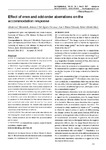Effect of even and odd-order aberrations on the accommodation response.
| dc.contributor.author | Moulakaki, AI | en |
| dc.contributor.author | Del Águila-Carrasco, AJ | en |
| dc.contributor.author | Esteve-Taboada, JJ | en |
| dc.contributor.author | Montés-Micó, R | en |
| dc.date.accessioned | 2018-09-20T17:39:39Z | |
| dc.date.available | 2018-09-20T17:39:39Z | |
| dc.date.issued | 2017 | en |
| dc.identifier.issn | 2222-3959 | en |
| dc.identifier.uri | http://hdl.handle.net/10026.1/12391 | |
| dc.description.abstract |
AIM: To investigate the potential effect that odd and even-order monochromatic aberrations may have on the accommodation response of the human eye. METHODS: Eight healthy subjects with astigmatism below 1 D, best corrected visual acuity 20/20 or better and normal findings in an ophthalmic examination were enrolled. An adaptive optics system was used in order to measure the accommodation response of the subjects' eyes under different conditions: with the natural aberrations being present, and with the odd and even-order aberrations being corrected. Three measurements of accommodation response were monocularly acquired at accommodation demands ranging from 0 to 4 D (0.5 D step). RESULTS: The accommodative lag was greater for the accommodative demands of 1.5, 3, 3.5 and 4 D for the condition in which the even-order aberrations were corrected, in comparison to that obtained for the natural aberrations and corrected odd-order aberrations for the same accommodation demands. No statistically significant differences were found between the accommodation responses under the three conditions. CONCLUSION: The odd and even-order aberrations are not helping the visual system to accommodate, because their partial correction do not affect the accommodation performance. | en |
| dc.format.extent | 955 - 960 | en |
| dc.language | eng | en |
| dc.language.iso | eng | en |
| dc.subject | Accommodation Response | en |
| dc.subject | Adaptive Optics | en |
| dc.subject | Monochromatic Aberrations | en |
| dc.title | Effect of even and odd-order aberrations on the accommodation response. | en |
| dc.type | Journal Article | |
| plymouth.author-url | https://www.ncbi.nlm.nih.gov/pubmed/28730088 | en |
| plymouth.issue | 6 | en |
| plymouth.volume | 10 | en |
| plymouth.publication-status | Published online | en |
| plymouth.journal | Int J Ophthalmol | en |
| dc.identifier.doi | 10.18240/ijo.2017.06.19 | en |
| plymouth.organisational-group | /Plymouth | |
| plymouth.organisational-group | /Plymouth/Faculty of Health | |
| plymouth.organisational-group | /Plymouth/Faculty of Health/School of Health Professions | |
| plymouth.organisational-group | /Plymouth/REF 2021 Researchers by UoA | |
| plymouth.organisational-group | /Plymouth/REF 2021 Researchers by UoA/UoA03 Allied Health Professions, Dentistry, Nursing and Pharmacy | |
| plymouth.organisational-group | /Plymouth/Users by role | |
| plymouth.organisational-group | /Plymouth/Users by role/Academics | |
| dc.publisher.place | China | en |
| dcterms.dateAccepted | 2017-03-07 | en |
| dc.rights.embargoperiod | Not known | en |
| rioxxterms.versionofrecord | 10.18240/ijo.2017.06.19 | en |
| rioxxterms.licenseref.uri | http://www.rioxx.net/licenses/all-rights-reserved | en |
| rioxxterms.licenseref.startdate | 2017 | en |
| rioxxterms.type | Journal Article/Review | en |


